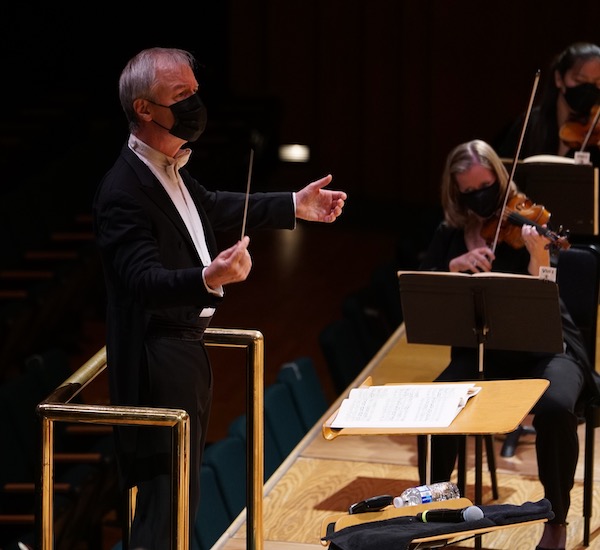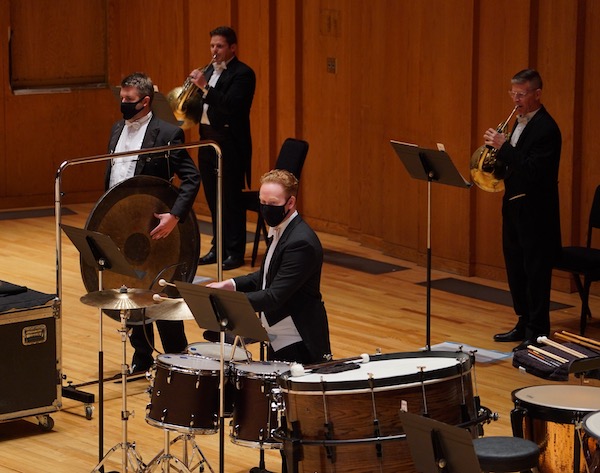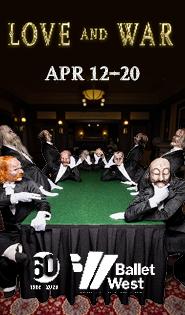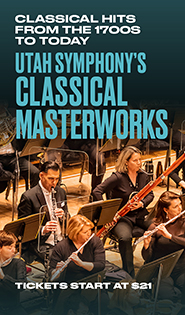Robertson makes an impressive debut with Utah Symphony

Conductor David Robertson made a welcome debut in Abravanel Hall Thursday night leading members of the Utah Symphony in an eclectic program of works spanning several hundred years, from the Renaissance to the late 20th century.
The Utah Symphony is in the early stages of its search for a successor to Thierry Fischer when the Swiss music director departs in 2023. (Fischer was originally scheduled to depart in August 2022, but recently agreed to a one-year extension of his contract).
So, one can only assume that Robertson—and other guest conductors this season—will be viewed as potential new music director. Having recently wrapped a successful 13-year tenure as music director of the St. Louis Symphony, the 62-year-old American conductor shoed himself a superb musician who would be a worthy successor to Fischer.
Robertson demonstrated his musical and interpretative chops Thursday in each of the two disparate halves of the program with the string, brass and percussion sections spotlighted in separate works. As in preceding weeks, the conductor and musicians were masked (except for brass).
The strings of the Utah Symphony were center stage in the evening’s first half featuring George Walker’s heartfelt Lyric and Antonin Dvořák’s delightful Serenade for Strings
Right from the first bars, one could tell that Robertson had a strong rapport with the Utah string players. They responded to his direction wonderfully, playing with striking feeling and expression. Robertson coaxed a warm, mellow sound from the ensemble that underscored the melodic richness of both the Walker and Dvořák works.
Walker’s Lyric is a fairly short piece but filled with an abundance of lush romanticism that Robertson conveyed to the ensemble.
Dvorák’s Serenade, on the other hand, is a substantial five-movement work that is one of the cornerstones of the string repertoire. Devoid of any dark, serious undertones, the music highlights the composer’s lighter side and Robertson brought that out in an ebullient reading.
Robertson’s tempo choices for each movement were leisurely, allowing the players to let the melodies sing. The opening movement was well crafted with finely shaded expressions, while the charming waltz that followed flowed with unassuming grace.
The third movement Scherzo was vivacious under Robertson’s spirited direction, and was balanced by the ensuing Larghetto, in which he elicited notably nuanced playing from the ensemble.
The finale was robust and decisive under Robertson’s baton and the strings played with precise and cleanly articulated phrasing.

Robertson exhibited a comparable rapport with the brass and percussion players after intermission. Here too the musicians delivered dynamic and energetic playing, which was tempered with seamless lyricism where needed.
Two fanfares bookended the second half, opening with Joan Tower’s Fanfare for the Uncommon Woman No. 1. The piece contrasts the horns with the low brass and trumpets, with percussion acting as a unifying element between the two. Aaron Copland’s rousing Fanfare for the Common Man ended the second half with Robertson eliciting a powerful performance that captured the majesty of the piece.
In between were several shorter brass and percussion pieces.
The renaissance composer Giovanni Gabrieli was featured with his Sonata pian’ e forte in Robertson’s own arrangement for seven brass players. The piece is antiphonal with the seven players placed in two groups on opposite sides of the hall, playing in dialogue with alternating loud and soft passages.
The Gabrieli was followed by the second and third movements of the French composer Henri Tomasi’s four-movement Fanfares liturgique for brass and percussion. The second movement, “Evangile,” has an extended solo for trombone that the symphony’s principal Mark Davidson played with fluid and lyrical expression. The “Apocalypse,” movement is martial and rhythmic and Robertson deftly brought to the fore the underlying sense of foreboding.
Short pieces by Edvard Grieg and Toru Takemitsu rounded out the concert.
Grieg’s somber Funeral March for Rikard Nordraak laments the loss of one of the Norwegian composer’s friends. Originally written for piano, the version played here was an arrangement for brass and percussion made in the 1970s by Geoffrey Emerson. None of the sensitivity of the original was lost in this version and Robertson ensured an essential warmth showed through the funereal inspiration.
Similar in mood to Walker’s Lyric is Takemitsu’s Night Signal – Signals from Heaven II. Robertson drew a sensitive reading that emphasized the reflective essence of the music.
The program will be repeated 7:30 p.m. Friday and Saturday. utahsymphony.org; 801-533-6683.
The season continues November 12-14 with a program featuring music by Suk, Biber, Rouse, Takemitsu and Mozart.


Posted Oct 29, 2020 at 5:37 pm by larry gerlach
Robertson is superb! I saw him 8-10 times with St. Louis, impressed every time by how he is truly evocative of the music, literally drawing you emotionally into the performance better than other conductor I have seen. The audience response spoke volumes to how much he impressed. Hope he can come back to conduct when we have a full house.
Posted Oct 31, 2020 at 5:51 pm by Charles Deneris
We enjoyed the concert very much, and really enjoyed Maestro Robertson. I hope he is in consideration as the next Music Director for the Symphony!